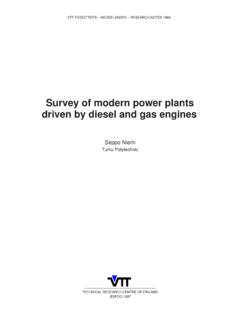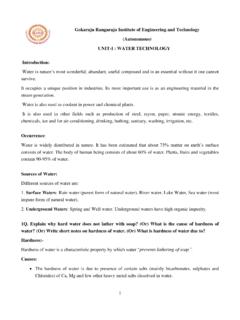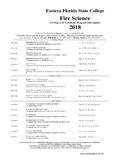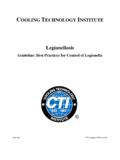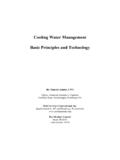Transcription of A new technology to manufacture polypropylene foam sheet ...
1 VTT PUBLICATIONS 361 TECHNICAL RESEARCH CENTRE OF FINLANDESPOO 1998A new technology to manufacturepolypropylene foam sheet andbiaxially oriented foam filmJaakko I. RaukolaVTT Chemical TechnologyThesis for the degree of Doctor of technology to be presentedwith due permission for public examination and criticism inFestia Auditorium 032, at Tampere University of technology ,on the 18th of September 1998, at 12 o clock 951 38 5257 1 ISSN 1235 0621 Copyright Valtion teknillinen tutkimuskeskus (VTT) 1998 JULKAISIJA UTGIVARE PUBLISHERV altion teknillinen tutkimuskeskus (VTT), Vuorimiehentie 5, PL 2000, 02044 VTTpuh. vaihde (09) 4561, faksi (09) 456 4374 Statens tekniska forskningscentral (VTT), Bergsmansv gen 5, PB 2000, 02044 VTTtel. v xel (09) 4561, fax (09) 456 4374 Technical Research Centre of Finland (VTT), Vuorimiehentie 5, 2000, FIN 02044 VTT, Finlandphone internat. + 358 9 4561, fax + 358 9 456 4374 VTT Kemiantekniikka, Materiaalitekniikka, Hermiankatu 8 H, PL 1402, 33101 TAMPEREpuh.
2 Vaihde (03) 316 3111, faksi (03) 316 3517 VTT Kemiteknik, Materialteknik, PB 1402, 33101 TAMMERFORStel. v xel (03) 316 3111, fax (03) 316 3517 VTT Chemical technology , Materials technology , 1402, FIN 33101 TAMPERE phone internat. + 358 3 316 3111, fax + 358 3 316 3517 Technical editing Leena UkskoskiOy EDITA Ab, ESPOO 19983 Raukola, Jaakko I. A new technology to manufacture polypropylene foam sheet and biaxiallyoriented foam film. Espoo1998, Technical Research Centre of Finland, VTT Publications cellular materials, foamed polymers, foam sheets, foam films, manufacturing,polypropyleneAbstractFoame d polymers are future materials with their wide application spheres. Theycan be used to enhance appearance as insulating structures or to save materialcosts. This study addresses all of these and concerns a new technology toproduce foamed tubes and films. An entire blown film extrusion line was builtup to fulfil the final target, biaxially oriented foam film with closed cell,microcellular foam conditions, which in general means temperature, pressure and flowcontrol of viscoelastic material, is discussed and examined experimentally todefine the dominating characteristics.
3 Screw and die design together with foamstabilisation is taken under stringent examination, resulting a three layer blownfilm die focused for foamed effects of chemical foam nucleating agents and physical and chemicalfoaming are examined during the study concluding in formation of cell embryosby chemical foaming agents and expanding them into low density foam withphysically compressed nitrogen gas. The effect of processing parameters infoam structure is examined and adapted according to the main characteristics of polypropylene were defined by rheologicalmeasurements to promote foaming studies in extrusion. Sharp melting point andlinear structure of polypropylene caused troubles in keeping the foam structureclosed during expansion, but was also partly resolved with new bimodal typepolypropylene owing to high melt strength applications, leading to new commercialised innovations in foam films,will also be discussed in greater experimental procedure of this study was carried out in the institute ofPaper Converting at Tampere University of technology (TUT).
4 Thecomposition of this study was further completed in the Technical ResearchCentre of Finland (VTT).I wish to express my deepest gratitude to my supervisor, Professor AnttiSavolainen for all the professional criticism that I needed to be motivated tofinish this also want to thank Walki-Wisa and especially Mr. Ilkka Lumme, Mr. HannuKarhuketo and Mr. Hannu Ollila, who had the courage to start the innovativestudy in the first am very grateful to VTT Chemical technology for the final settings to finishthis work and to SICPA Oy for their support and trust in offer my special thanks to my co-workers Mr. Kari Kirjavainen (VTT) and Kontiainen ( kerlund & Rausing Oy) from fruitful also wish to acknowledge the help and support provided by the staff in thePaper Converting and most of all, I wish to thank my wife, Kirsi, my two lovely daughters,Kati and Suvi, and my wonderful son, Otto, for offering me an interdisciplinarybut very functional combination of family and this , April 1998 Jaakko Raukola5 ContentsABSTRACT3 PREFACE4 ABBREVIATIONS71 INTRODUCTION102 The Formation of Foam Structure in Polymers Foam Bubble Foam Foaming Foam Nucleating Polymer Rheological Properties of Polymers26 Foam PP Film Manufacturing333 EXPERIMENTAL PROCEDURE.
5 RESULTS AND PP Foam Extrusion Machinery and Foam Biaxially Oriented Foam Film Processing Material Molecular Structure and Thermal Rheological Properties with Cone and Plate Rheological Properties with an Extrusion Foam Evaluation with a Capillary Small Particles as Foam Interphase of Another Polymer as a Foam Chemical Foam Nucleating The Effect of Temperature on Foam The Effect of Gas Pressure on Foam The Effect of Melt Pressure on Foam Foam Studies with a Three Layer Rotor polypropylene Foam Extrusion with Chemical polypropylene Foam Extrusion with Solid Particle Foam Studies with a Flat Film A Summary of the Experimental Results, Applications and Further Interests87 4 CONCLUSIONS91 REFERENCES937 Abbreviations G*hom Gibbs free energy for homogenous nucleation G*hetGibbs free energy for heterogenous nucleation bp surface energy on gas bubble/polymer interface Pgas pressure inside a foam cellS( )contact angle between a pareticle nucleator and gas Ghomchange in Gibbs free energy for homogenous nucleation Ghomchange in Gibbs free energy for heterogenous nucleation GGibbs free energyCrnnucleation rateCLScritical limiting supersaturationGBDgrowth by diffusionRSNrapid self nucleationSsaturation Fsystem free energy surface tensionAinterfacial area ppressure differencerbubble radiuspggas pressurekHenry s law constantcwmass fraction gas at the bubble surfaceDdiffusion coefficientDodiffusion coefficient (material dependent)
6 EDactivation energy in diffusionRideal gas law constantTtemperaturepLexternal pressureA*Hamaker constantaaverage length wall thicknessCFCfluorocarbonPSpolystyrenePPp olypropylene aapparent shear rate8 wshear rate on wallQvolumetric flow ratewslit widthhslit thickness wshear stresspexitexit pressureJeelastic compliance 11 , 22 normal stressMwweight-average molecular weightMn number-average molecular weightMz z-average molecular weightMz+1 z+1-average molecular weightEMFelectro mechanical filmMWDmolecular weight distributionPTFE polytetrafluoroethylenePOMpolyoxymethyle nePETpolyesterG dynamic storage modulusG dynamic loss modulusL/Dlength to diameterTg glass transition temperatureVvolumetric flowPE polyethyleneNOPP nonoriented polypropyleneOPPoriented polypropyleneBOPP biaxially oriented polypropyleneCTMcavity transfer mixerUCUnion Carbidedcapillary diameterMDmachine directionTDtransverse directionTme melt temperatureTD die temperaturepm melt pressurepg gas pressurepb film blowing pressure9n1 ,n2 , n3.
7 N4speed of rotationFb buoyant forcemweight densityMFRmelt flow rateTm melting temperatureTcr crystallization temperatureMmolecular weightPIpolydispersity indexDSCdifferential scanning calorimetryMFImelt flow indexBURblow up ratioCFAchemical foaming agent101. INTRODUCTIONThe use of polymer foams in today s world has constantly increased. Manyreasons support this growth: light weight, insulation properties, softness,excellent strength/weight ratio, material costs, energy absorptionperformance etc. Many times reductions after foaming in material costs arearound 30 % without compromising the function or required strength, whichis one of the advantages that could lead to even wider use of foams inindustry. The chemicals used are today environmental friendly and themechanical and barrier properties can be greatly affected by multilayerconstructions; mechanically strong sandwich structures can be produced withsolid skin layers, low gas permeability polymers and tie layers support theiruse for high barrier main applications for foamed plastics can be found in the building,automobile, packaging and sport industries.
8 They include the end productsfor insulative sheets, floor coverings, profiles for finishing, automobilelinings, packaging films, cable wires, interior finishing, shoes and of environmental demands, foamed polymers have also beenthreatened and raw material and process manufacturers have been forced tofind solutions for recyclable polymers, more flame and temperature resistivestructures and alternatives for blowing agents deleterious effects on theozone layer. These challenges have led studies more away from thetraditional materials, polystyrene and polyurethane and towards the use ofpolyolefins, polyethylene and polypropylene [1, 2, 20, 43].The use of polymeric foams in sandwich structures is also cheaper comparedto honeycomb structures and does not increase the weight of the surfaces can be cohesively bonded to the foamed core, whichsimplifies the processing [65].
9 112. The Formation of Foam Structure in PolymersA foamed polymer can be understood as a structure of two phases; gas andpolymer. To make the phases in a uniform, homogenous order a third solidcomponent, the nucleator, is methods can be divided into chemical and physical foaming. Inchemical foaming chemical nucleating agents are added in melt polymer andfoaming gas is produced by decomposition of the nucleator at a certaintemperature (Figure 1). In physical foaming the polymer, which has a smallamount of nucleating agents is saturated with external gas, the foaming is introduced in the literature mainly as a batch process,where nucleating agents are mixed with the polymer, which is separatelysaturated with gas below the glass transition temperature (Tg) under highpressure. A supersaturated specimen is produced when pressure is the specimen is now heated again above the glass transitiontemperature, the foam cells nucleate spontaneously.
10 Cell growth is undercontrol due to the glassy polymer, which is slowly heated. This gives a goodbasis for studies of cell formation and growth. Most of the studies are moreconcentrated on chemistry and nucleation theories of polystyrene with batchprocess instead of process technology of foamed continuously extrudedpolyolefins. In high pressure batch foaming the foam extent is high anddensities less than g/cm3 can easily be reached. Fine microcellular foamstructure can be achieved and the diameter of the bubbles is less than 20 m[10, 19, 20, 27]. Batch foaming is commonly used for low density foamedproducts with a certain shape. The advantages are high foam extent,microcellular closed cell structure and high mechanical strength. Forcommercial applications the pressure to supersaturate the semifinishedproduct is high, which increases the costs of the process.



